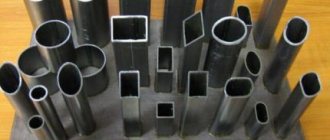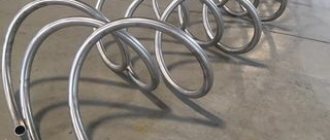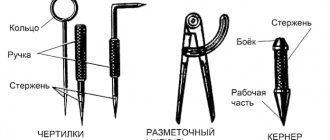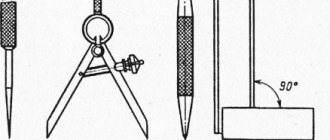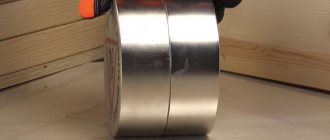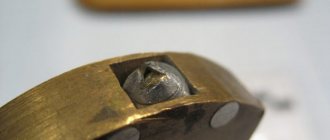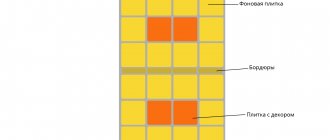Pipes are the most common type of rolled metal and plastic. These products are used in various fields. Depending on the purpose, the products are cut to the required length, evenly or with a bevel at a certain degree. Several methods are used for cutting, including using a grinder. You can understand how to cut a pipe smoothly with a grinder by learning all the intricacies of cutting.
Cutting metal with a grinder
How to cut a pipe evenly with a grinder
To ensure an even cut from the grinder, it is recommended to use special devices for fixing the metal workpiece. Prepared templates, miter boxes or vices are suitable for this.
It is necessary to mark the place for cutting very evenly so that the cut does not go to the side. For large volumes of work, for industrial purposes, special equipment in the form of lathes or tape machines is used to cut pipes.
You can make vertical and horizontal cuts on a metal profile, and cut it at any angle.
Method 3 Use a vice and a hacksaw
This method is suitable for small volumes of work, with small cross-sectional sizes of an iron pipe, angle, steel strip, helical stud, etc.
At a theoretical level, you can manually saw off a metal pin five to seven cm in diameter or a 50 by 50 corner half a centimeter wide. True, this will take more than one hour of time and will require a lot of strength and endurance.
If you don’t have a hacksaw for metal, then from time to time an ordinary ratfil will help, but rather not for cutting, but for cutting metal (for example, a thin rod for the next bending).
Cutting pipes at right angles
The technology for cutting at right angles is quite simple. You just need to fix the metal part, mark the cut line, and directly cut the workpiece. The end of the cut part of the pipe should be above the support.
To mark the cut, use wide or narrow tape, a marker or a simple pencil. You just need to wrap the product, mark the cut location, and make an even cut. When winding, both ends of the tape must fit together accurately
Let's spin
The method that I use in most cases when cutting pipes of small diameters.
I place the pipe against the wall, with the free end resting it against a corner (if necessary, I put something under it to prevent the pipe from rolling away). At the place of the cut, I touch the pipe with a pencil or marker. So that my hand does not tremble, I rest it on the wall. I rotate the pipe by the edge, and the pencil outlines an even cutting line.
It may seem that the method is only suitable for small pipes. At one point we managed to mark a pipe a little over a meter in diameter.
Once they brought to the workshop a pipe three meters long and something about 20 meters in diameter, I don’t remember exactly. They ordered it to be trimmed. Frankly speaking, this is an unusual task for us. But we managed.
After a brainstorming session, we drove to a carpenter and brought in a factory-made sheet of plywood. One side was placed tightly under the pipe (at an angle to the future cutting line). along the second side along the floor - this is a perpendicular.
Further, everything, as described above, is exclusively on a huge scale. Two men rolled the pipe, trying to do it very moderately. The 3rd placed a marker on the pipe and guided it along the mowing line marked on the floor. At the end, the marking closed, which means we succeeded. There are no unsolvable problems. You just need to be resourceful.
That's all for me. Thanks for reading. If the article was useful, subscribe to the channel and, of course, give it a thumbs up.
Methods for cutting metal products at an angle
Conventional perpendicular cutting at 90°, using a grinder, is carried out quickly and efficiently, if you do not neglect the advice of specialists.
Many people believe that if a large tool with a large powerful disk is used for sawing, then there is no need to apply markings. Experts do not recommend sawing without marking, because after cutting the parts may not align.
Note! Before you understand how to cut a pipe evenly with a large grinder, it is better to make markings several times to make sure the calculations are accurate. After cutting a profile or gas pipe incorrectly, you will have to start working all over again.
Features of cutting a cylindrical pipe at 45
Most often, making a cut at an angle of 45 degrees is required when installing heating or plumbing systems. The main difficulty in carrying out the work is that after combining the cut parts of the pipe, a right angle of 90 degrees should be obtained. A simple way to prepare a homemade pattern will help you achieve the quality of the cutting process:
- Prepare a plain white sheet of paper.
- Fold it diagonally.
- The protruding part of the sheet must be cut off with scissors so that when unfolded you get a square.
- The resulting triangle must be wrapped around the pipe so that the long side runs parallel to the section.
A paper template is great for cutting metal products in the middle.
Paper template
The resulting triangle, folded in half, must be divided into two parts. Then the templates need to be wrapped around the pipe and secured with tape or tape. The templates should be positioned so that one edge of the base coincides with the second.
Use scissors to round the top corners of both templates. The resulting two blanks of the required diameter should be placed on the pipe, and the cut location should be marked with chalk or a pencil. The prepared marked part can be safely sawed off.
For small diameter tubes that need to be cut close to the edge, the marking method using a container of water is suitable. The desired angle of inclination of the cut is marked on a deep container, then the end of the tube is placed in the water and tilted towards the marking. The line of contact with the liquid will become a cutting mark.
How to mark a 45mm cut on a profile pipe
Not everyone knows how to cut a profile pipe at 45 degrees with a grinder correctly and efficiently. Experts advise using an ordinary triangular ruler to mark a profile pipe with a square cross-section.
First, a straight strip should be drawn on one of the faces, located perpendicular to the side of the pipe. Then the workpiece must be rotated and an oblique mark applied to the adjacent face. It should go from the edge of the first strip at an angle of 45 degrees.
After this, the product is turned again and a perpendicular line is drawn. On the fourth side, all that remains is to connect the previously drawn stripes diagonally. Now you can start cutting.
Additional Information! Many experts believe that the best way to mark professional pipes is a tape measure. However, using this tool it is very difficult to do the job perfectly; the cut may turn out uneven. The school ruler will do the job much better.
Required Tools
In order to cut a pipe along , it is very important to choose the right tool. The quality of work depends on it in almost everything. So, let's look at more suitable tools for working on a pipe:
- Bracelet with a hole. This equipment is designed specifically for making the cut. It is comfortable and allows you to get the job done perfectly;
- Jigsaw. Allows you to make an even and careful cut. In this case, you will not have to obtain special equipment;
- Ratfil. And in this case, the cut comes out smooth and of high quality. But working with both a ratfile and a jigsaw takes quite a lot of time;
- Bulgarian. The tool allows you to get the job done quickly and relatively easily. But there are also disadvantages. The cut is not even enough.
You can choose the tool that is more suitable for you, or that is already available in your workshop.
The nuances of working with a rectangular section
Rectangular workpieces are much easier to cut lengthwise and crosswise at any angle than cylindrical elements, which are difficult to hold motionless on a flat surface. Transverse cutting of workpieces at any angle does not present any particular difficulties - a line of suitable angular inclination is carried out on the side edge and always coincides with the calculated one (round elements require the use of special patterns, calculated on a computer, to align their edges at an angle different from the straight one).
The thickness of metal profile walls when used in households occasionally exceeds 5 mm - it is easy to cut it using an angle grinder with any kind of metal disc.
Rules for cutting pipes from different metals
A grinder, even in the hands of a master, is a rather dangerous tool. When working with it, you should take precautions and be as focused as possible. Otherwise, you can not only damage the metal workpieces, but also injure yourself.
Every metalworking specialist should know how to properly cut a pipe at 45 degrees with a grinder. The disc circumference should be installed with the pattern facing up, and clamped with a special nut. Pipes made of different metals are cut in compliance with certain rules.
Working with aluminum blanks
Aluminum is a soft type of metal, so a different type of disc is used for cutting with a grinder. When working with soft metals such as aluminum or copper, it is impossible to make the cut in one go. The cutting disc simply gets stuck in the material.
Cutting with a special disc is performed very carefully. You need to go through the same section several times.
Cutting aluminum pipes
How to cut cast iron pipes
Cast iron is characterized by increased strength, but at the same time it is a rather fragile material. For sawing cast iron pipes, it is recommended to use diamond-coated discs. You can cut fragile material with a grinder only in a straight line.
Important! It is necessary to carry out work with sawing cast iron, steel, and aluminum only with the use of personal protective equipment (wearing a respirator, safety glasses and gloves). During the cutting process with a grinder, a large amount of dust is generated.
Cutting large pipes
The grinder is often used for cutting large diameter pipes. Large metal products have thicker walls and greater weight. To work with large metal workpieces, it is more convenient to choose large disks.
Heavy, non-lifting products must be firmly installed on low supports or on a flat surface so that they do not change their position when cutting the final section.
When working with large pipes, you should choose the correct direction of rotation of the grinder disk circle. Otherwise, it is difficult to hold the tool in a fixed position, and the disc wears down too quickly.
Tools for home and semi-professional use
To install water supply or sewerage systems, heating and ventilation circuits in home construction or when providing construction services, tools from this category are often used.
Some of the more common devices include:
- Cutters with pruner design. This tool is used for cutting polymer pipes whose cross-section does not exceed 75 mm. The gear mechanism of the device allows you to apply the force necessary for work. The design of such a cutter provides a special shelf on which the pipe , which ensures the evenness of the cut strictly at 90º. Prices for such tools can be very different, everything depends on their properties, dimensions, capabilities, manufacturer and other reasons.
- Disc type pipe cutter. In such a device, the pipe is cut by a special disk, which is made of strong material and has sharpened edges. Using a lever, the cutting disc is pressed against the surface of the pipe and guided along its cross section.
Features of cutting thin-walled pipes
Sawing thin-walled metal has its own characteristics. When cutting these products, there is a high risk of crushing the edges at the cut points. To prevent this, experts recommend filling the pipes from the inside.
A wooden stick of suitable diameter or sand may be suitable as a filler. For a thin-walled profile, when cutting with a grinder, thin cutting discs are chosen. Working with such material is much faster.
Gas pipe cutting
Mark by tape measure
The second method of marking the pipe is suitable if one of its ends is even. To mark, take a tape measure, cling to the straight end and measure the required length of the profile using it. According to its scale, a mark is made on the pipe, first at one side, later at the second. The marked points are connected with a marker into a fishing line. The reverse side of the pipe is marked using the same method.
Next, the angle grinder is used to cut the pipe one mowing line at a time; later the profile is turned over and a cut is made in the opposite direction. Afterwards it is laid on its side and cut by eye, guided by the protruding cuts on the edges of the pipe. If the profile is wide, then you can immediately outline all 4 sides and connect the points under a ruler so as not to distort the cut, especially on the last two sides.
How to cut a gas pipe correctly
The work of cutting gas pipes is dangerous and quite difficult, so it is best left to the professionals. Before starting work, be sure to turn off the gas supply.
The next step involves freeing the pipe cavity from residual gas. To do this, you need to light the gas burners on the stove and wait for them to go out. Only after carrying out the above manipulations should you begin marking and subsequently cutting the metal.
High-quality cutting of metal pipes is a complex process. However, if you take precautions and listen to the advice of professionals, you can cut metal of any density and thickness using a grinder. A grinder with a cutting round disc is rightfully considered a universal tool in everyday life. The main rule is not to forget about safety precautions when working with dangerous cutting tools.
Cutting a round hole in metal using an angle grinder
In reality, it is often necessary to cut a circle in metal, and the only tool available is a machine. How to cut slate has been produced with a wave and grinder since the times of the USSR. Alas, it is quite enough for this. The algorithm of actions is simultaneously as follows.
- Draw a circle with a compass on metal or on a pre-made paper (cardboard) template with chalk, also called a marker.
- Holding the grinder at an angle to the surface of the sheet, make a preliminary marking cut of the metal along the marked contour, making short movements with the disk (sawing in small sections).
- Then, moving the nozzle in the same way, deepen the slot until it is completely cut out.
You need to cut along the outer contour of the circle so as not to reduce the size of the circle. If its diameter is small, then they cut by touching the metal with a disk point by point (without longitudinal movement of the nozzle). The round hole will have an oblique cut, additionally with some minor flaws (they depend on the skill of the worker). Afterwards, it is processed, if desired.
The process of cutting a round hole in sheet metal using a special device is shown in the video:
General information
Please note that at the moment it is even impossible to imagine the work of repairmen, builders, mechanics and mechanics without an angle grinder. With its help, you can cut various materials, including metal - rods, fittings, water pipes, profiles and corners.
The cut obtained from an angle grinder can be ground, sharpened or polished. An incredibly large selection of interchangeable attachments helped make this tool universal and indispensable. At the same time, it would be dishonest to mention that this is the most dangerous electric tool. To cut metal, you will definitely need the material itself, a face mask, an angle grinder, glasses and replacement discs.
We measure
The first method is not entirely convenient, but quite accurate. Suitable if you are “in the tundra” and have nothing at hand except a pencil and tape measure. I had to use it a couple of times. The diameter of the pipes does not matter.
An important condition is the presence of a flat plane near the cut. This could be the edge of a pipe, a socket, a put-on or welded-on coupling, a seam, or any other concentric circle.
We mark the place of the cut with a risk. We measure the distance from the mark to a flat plane. We rearrange the tape measure along it and make risks in a circle, using the given size. We get a circle from the marks.
Decorative solutions
A plastic corner is the most common and affordable option for decorative finishing of various joints in the bathroom. The use of such a corner helps to hide all aesthetic defects that arise as a result of rough sealing of seams. The corner can close gaps up to 3 cm wide. It is recommended to fasten the baseboard using transparent sanitary silicone. Silicone is an excellent adhesive, provides additional sealing, and also contains antifungal additives, which is necessary when finishing a bathroom.
Border tape is the easiest and fastest way to close a gap up to 3 cm. The tape is a strip of polyethylene with an adhesive base. To glue it, you just need to degrease the work surface, measure and cut the required piece and attach it, pressing with your fingers, to the gap. Border tape without an adhesive layer is installed using silicone.
Experts recommend purchasing border tape without an adhesive base and installing it using silicone. This way it will last longer.
You can fill the gap with tiles. It is better to use tiles left over after tiling the walls. If there are no tiles left after the renovation, you can purchase several pieces of white tiles of such a size that a minimum of trimming is required. If the bathtub is white, the tiles will blend in with it and the borders will be almost invisible.
Sometimes when decorating walls with tiles, craftsmen use a decorative ceramic border. The same border can also be used to decorate the joints. Attach it to the surface using waterproof glue or liquid nails.
Compliance with safety regulations
How to saw correctly with a grinder, following safety rules? Angle grinder designers always try to minimize the likelihood of any injury.
One of the main dangers that a person may encounter when cutting metal is the flying of fragments of a damaged disk. Small abrasive particles may fly out. If the disk of the construction device is damaged, the angle grinder may fly out of your hands at the most unexpected moment.
Therefore, when you perform light work, safety precautions must be followed. Before you start cutting you need:
Directly while working with the grinding machine you need to:
Upon completion of the work performed, you should:
Many people use saws or cutters instead of a blade. You can't do this.
Disk selection
Before choosing a specific disk, you need to determine what it will be used for. You need to pay attention to two characteristics of the disk - diameter and thickness.
The smallest disc diameter is 125 millimeters, the largest is 250 millimeters. Discs intended for professional use may have a large diameter. Another parameter of the disk depends on this parameter – thickness.
If the material you want to cut is any metal, you should buy a cutting disc, because the cutting disc has the smallest thickness - one millimeter. The thickness of the discs of grinding machines for industrial production is two and a half millimeters. Thanks to this thickness of the disc, cutting metal will be much easier. You will be able to get a neat cut.
According to many people, it is necessary to use a diamond blade to cut any metal. But that's not true. After the first use, such a disk becomes unsuitable for further use. Cutting metal with a grinder is a simple procedure that even beginners can handle.

